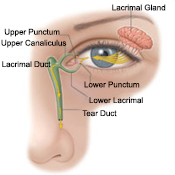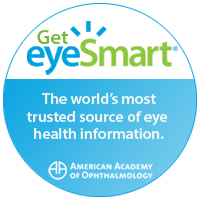
Normally, the eye constantly bathes itself in tears. By producing tears at a slow and steady rate, the eye remains moist and comfortable. Sometimes people do not produce enough tears or the appropriate quality of tears to keep their eyes conformable. This condition is knows as dry eye.SYMPTOMS OF DRY EYE
- Stinging or burning eyes
- Scratchiness
- Stringy mucus in or around the eyes
- Excessive eye irritation from smoke or wind
- Excess tearing
- Discomfort when wearing contact lenses
Excess tearing from dry eye may sound illogical, but it can be understood as the eye’s response to discomfort. If the tears responsible for keeping the eyes lubricated do not keep the eye wet enough, the eye then becomes irritated. Eye irritation prompts the gland, which makes the tears (lacrimal gland) to release a large volume of tears, overwhelming the tear drainage system. The excess tears then overflow from your eye.

TEAR FILM
When a person blinks, a film of tears spreads over the eye making the eye surface smooth and clear. Without this tear film, good vision would not be possible.
The tear film has three layers and each layer has its own purpose:
- An oily layer
- A watery layer
- A layer of mucus
The oily layer that is produced by the meibomian glands forms the outermost surface of the tear film. Its main purpose is to smooth the tear surface and reduce the evaporation of tears.
The middle watery layer makes up most of what we usually think of as tears. This layer is produced by the lacrimal glands in the eyelids which cleanses the eye and washes away foreign particles.
This inner layer consists of mucus produced by the conjunctiva. This mucus allows the watery layer to spread evenly over the surface of the eye and helps the eye remain moist. Without mucus, tears would not adhere to the eye.
CAUSES OF DRY EYE
As we age, tear production normally decreases. Dry eye can occur in both men and women at any age, although women are most often affected, especially after menopause. Dry eye can also be associated with other conditions such as Sjogren’s syndrome, Lupus, Rheumatoid Arthritis and some types of Thyroid disease.
A wide variety of medications can also cause dry eye. Always tell your ophthalmologist the names of all of the medication you are taking, especially if you are using the following:
- Diuretics
- Beta-blockers
- Antihistamines
- Sleeping pills
- Pain relievers
If these medications can not be avoided, dry eye may have to be treated with artificial tears.
DRY EYE DIAGNOSIS
An ophthalmologist is usually able to diagnose dry eye during an exam. A test to measure tear production may be necessary. The Schirmer tear test involves placing filter paper strips under the lower eyelids to measure the rate of tear production under various conditions. Another test uses diagnostic drops to look for certain patterns of dryness on the surface of the eye.
DRY EYE TREATMENT
ADDING TEARS
Artificial tears are similar to our own tears. The purpose of the artificial tears is to lubricate the eyes and maintain moisture. Artificial tears are available without a prescription. Preservative-free eye drops are an option for patients who are sensitive to the preservatives in artificial tears. If you find that you need to use artificial tears every more than every couple of hours, preservative-free brands may be better suited for you.
Other treatment options may include ointments, gels and punctal plugs.
CONSERVING TEARS
Conserving your eyes’ own tears is another approach to keeping your eyes moist. Tears drain out of the eye through a small channel into the nose. Your ophthalmologist can close these channels either temporarily or permanently. The closure conserves your own tears and makes artificial tears last longer.
OTHER METHODS
Tears evaporate like any other liquid. To prevent evaporation when in windy weather, try using wrap around glasses, which may reduce the drying effect. Patients with dry eye should avoid overly warm rooms, hair dryers and smoking which can be especially bothersome. Some patients may find some relief from dry eye by taking omega-3 fatty acids and flax seeds. Ask your ophthalmologist if these supplements are right for you and if so, in what form and dosage. If other methods to not provide adequate relief from dry eye, your ophthalmologist may prescribe a prescription medication such as Restasis®, which works to resolve your symptoms by stimulating tear production.
Lauderdale Eye Specialists provides this on-line information for educational purposes only and it should not be construed as personal medical advice. Lauderdale Eye Specialists disclaims any & all liability for injury or other damages that could result from use of the information obtained from this site.


